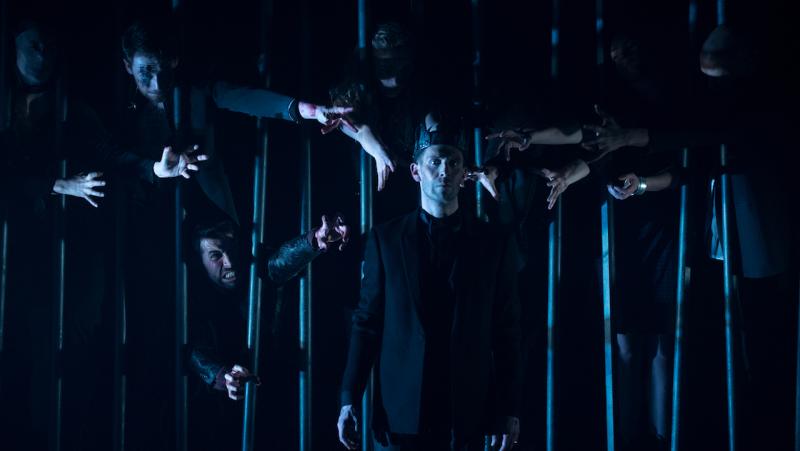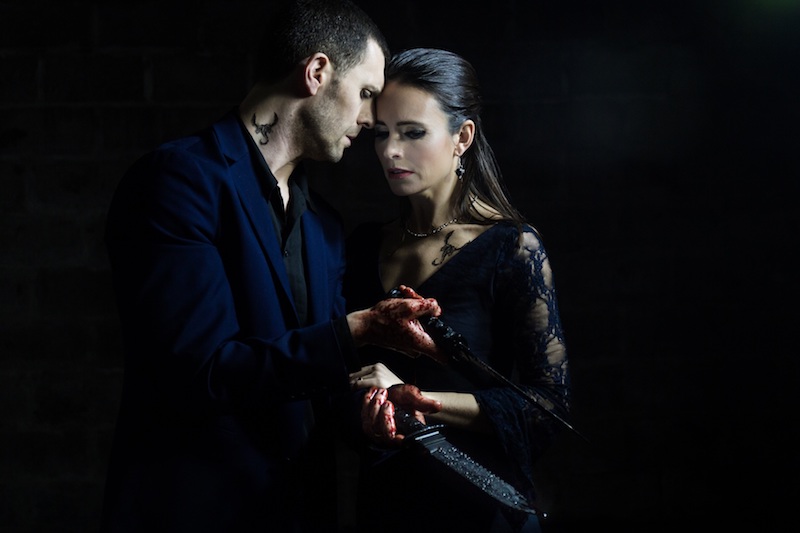Macbeth, Wilton's Music Hall review - incisive and thrilling dance theatre | reviews, news & interviews
Macbeth, Wilton's Music Hall review - incisive and thrilling dance theatre
Macbeth, Wilton's Music Hall review - incisive and thrilling dance theatre
Mark Bruce Company's wordless take on the Scottish Play is stunning

There’s more than a touch of vaunting ambition in the idea of turning the Scottish Play into dance theatre. Without spoken text, named scenes or even a printed synopsis, it falls to choreography and direction to speak for them all.
The grand dilapidation of Wilton’s Music Hall helps set the scene even before you’ve taken your seat. On stage, a foggy twilight reigns, relieved by lightning, so that throughout the show’s fleet 90 minutes you’re not always certain what you’ve seen. Was that one of the witches lolling against the scaffolding, or all three of them in a clinch? Did murdered Duncan’s corpse just raise its arms as it burned on the funeral pyre? Severed heads on pikes appear to morph into a teeming army.
Many of these grisly effects are created by Guy Hoare's lighting. On a raised stage with no proscenium or curtain, every human shape is sculpted by light, every scene change cued by it, blackouts acting as punctuation. In a story so “stepp’d in blood” it is remarkable how few of Macbeth’s murderous deeds we actually witness. Instead, we see the before and after – a decision that pays dividends in dramatic tension and a lingering sense of menace.
Darkness is pretty much a given in this tale, but Bruce sometimes defies expectation. His witches are more like Scots lassies on the razzle with their short tight skirts, clumpy shoes and tattooed limbs. The prophecies on the heath are represented by objects they fish from their capacious handbags, including a severed head and a series of grotesque baby dolls.
Props also play a chilling part in the stylised battles, a vortex of leaping and turning and wielding of knives. Each time, in defeat, the enemy falls prey to a ritual beheading, calling for a special sword removed with care from a special box. This daringly slows momentum but sticks horribly in the mind’s eye, not least for the 21st-century parallels it conjures up.
The company’s nine dancers work hard (some of them doubling roles) and Bruce’s muscular, sensual choreography amply fills the space. It’s not all grim. There are hints of knees-up Scottish dancing at the banquet before Macbeth starts losing the plot.
the arc of the pair’s joint downfall is never less than deftly drawnJonathan Goddard in the title role starts out as a quiet presence, sober and precise in a dark suit. It’s Eleanor Duval’s Lady M (pictured above with Goddard) who draws the eye, swivelling silkily in her satin tube of a dress and flexing her double-jointed hands suggestively. The pair have real chemistry, which is to say a properly toxic one, and before long she is a heap on the floor, scratching at her bloodied wrists like a bad case of eczema, and he is hollowed out by paranoia and self-loathing.
Given Goddard's celebrated virtuosity, it’s tempting to complain that he’s not given much chance to let rip. But the arc of the pair’s joint downfall is never less than deftly drawn, and Goddard, when he does briefly erupt into furious action, cuts shapes in the air that fizz with electricity.
The soundtrack, curated by the choreographer, is perhaps the most powerful driver of all. Drawing mainly on devotional music by Arvo Pärt, it also features bits of Schubert, Sonic Youth and the terrifying microtonal string writing of Krzysztof Penderecki. At one point, there is a sound that could only be the result of the massacre of a million starlings as they hit a wind farm. Either that or the screaming inside the head of a man who has murdered his way to power.
rating
Share this article
The future of Arts Journalism
You can stop theartsdesk.com closing!
We urgently need financing to survive. Our fundraising drive has thus far raised £49,000 but we need to reach £100,000 or we will be forced to close. Please contribute here: https://gofund.me/c3f6033d
And if you can forward this information to anyone who might assist, we’d be grateful.

Subscribe to theartsdesk.com
Thank you for continuing to read our work on theartsdesk.com. For unlimited access to every article in its entirety, including our archive of more than 15,000 pieces, we're asking for £5 per month or £40 per year. We feel it's a very good deal, and hope you do too.
To take a subscription now simply click here.
And if you're looking for that extra gift for a friend or family member, why not treat them to a theartsdesk.com gift subscription?
more Dance
 'We are bowled over!' Thank you for your messages of love and support
Much-appreciated words of commendation from readers and the cultural community
'We are bowled over!' Thank you for your messages of love and support
Much-appreciated words of commendation from readers and the cultural community
 R:Evolution, English National Ballet, Sadler's Wells review - a vibrant survey of ballet in four acts
ENB set the bar high with this mixed bill, but they meet its challenges thrillingly
R:Evolution, English National Ballet, Sadler's Wells review - a vibrant survey of ballet in four acts
ENB set the bar high with this mixed bill, but they meet its challenges thrillingly
 Like Water for Chocolate, Royal Ballet review - splendid dancing and sets, but there's too much plot
Christopher Wheeldon's version looks great but is too muddling to connect with fully
Like Water for Chocolate, Royal Ballet review - splendid dancing and sets, but there's too much plot
Christopher Wheeldon's version looks great but is too muddling to connect with fully
 iD-Reloaded, Cirque Éloize, Marlowe Theatre, Canterbury review - attitude, energy and invention
A riotous blend of urban dance music, hip hop and contemporary circus
iD-Reloaded, Cirque Éloize, Marlowe Theatre, Canterbury review - attitude, energy and invention
A riotous blend of urban dance music, hip hop and contemporary circus
 How to be a Dancer in 72,000 Easy Lessons, Teaċ Daṁsa review - a riveting account of a life in dance
Michael Keegan-Dolan's unique hybrid of physical theatre and comic monologue
How to be a Dancer in 72,000 Easy Lessons, Teaċ Daṁsa review - a riveting account of a life in dance
Michael Keegan-Dolan's unique hybrid of physical theatre and comic monologue
 A Single Man, Linbury Theatre review - an anatomy of melancholy, with breaks in the clouds
Ed Watson and Jonathan Goddard are extraordinary in Jonathan Watkins' dance theatre adaptation of Isherwood's novel
A Single Man, Linbury Theatre review - an anatomy of melancholy, with breaks in the clouds
Ed Watson and Jonathan Goddard are extraordinary in Jonathan Watkins' dance theatre adaptation of Isherwood's novel
 Peaky Blinders: The Redemption of Thomas Shelby, Rambert, Sadler's Wells review - exciting dancing, if you can see it
Six TV series reduced to 100 minutes' dance time doesn't quite compute
Peaky Blinders: The Redemption of Thomas Shelby, Rambert, Sadler's Wells review - exciting dancing, if you can see it
Six TV series reduced to 100 minutes' dance time doesn't quite compute
 Giselle, National Ballet of Japan review - return of a classic, refreshed and impeccably danced
First visit by Miyako Yoshida's company leaves you wanting more
Giselle, National Ballet of Japan review - return of a classic, refreshed and impeccably danced
First visit by Miyako Yoshida's company leaves you wanting more
 Quadrophenia, Sadler's Wells review - missed opportunity to give new stage life to a Who classic
The brilliant cast need a tighter score and a stronger narrative
Quadrophenia, Sadler's Wells review - missed opportunity to give new stage life to a Who classic
The brilliant cast need a tighter score and a stronger narrative
 The Midnight Bell, Sadler's Wells review - a first reprise for one of Matthew Bourne's most compelling shows to date
The after-hours lives of the sad and lonely are drawn with compassion, originality and skill
The Midnight Bell, Sadler's Wells review - a first reprise for one of Matthew Bourne's most compelling shows to date
The after-hours lives of the sad and lonely are drawn with compassion, originality and skill
 Ballet to Broadway: Wheeldon Works, Royal Ballet review - the impressive range and reach of Christopher Wheeldon's craft
The title says it: as dancemaker, as creative magnet, the man clearly works his socks off
Ballet to Broadway: Wheeldon Works, Royal Ballet review - the impressive range and reach of Christopher Wheeldon's craft
The title says it: as dancemaker, as creative magnet, the man clearly works his socks off
 The Forsythe Programme, English National Ballet review - brains, beauty and bravura
Once again the veteran choreographer and maverick William Forsythe raises ENB's game
The Forsythe Programme, English National Ballet review - brains, beauty and bravura
Once again the veteran choreographer and maverick William Forsythe raises ENB's game

Add comment